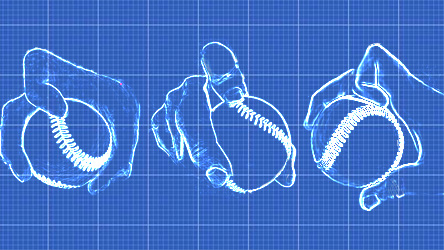The knuckleball is a beautiful, mysterious, fang-toothed monster of a pitch. It is Ali-like in its ability to both float and bite, seemingly at random. It’s uncontrollable for throwers, catchers, and prospective hitters. It’s no wonder so much virtual ink has been spilled in an attempt to describe its insanity.
And then there’s its lesser-known, seldom-loved cousin: the knuckle curve.
The knuckle curve is certainly the redheaded stepchild of pitches. It asks nothing of you; it merely gives. It’s a humble, workman-like, lunchpail-toting sort of pitch. It’s there when you need it, but out of the way when you don’t.
The knuckle curve is also, by my estimation, experiencing a bit of a renaissance. While only two pitchers in the majors currently throw a regular ol’ knuckleball, the Boston Red Sox themselves have had more pitchers the past few years who have employed some sort of knuckle curve, and noted Effectively Wild fan (and host) favorite Brian Bannister is a believer.
Said Bannister of the knucklecurve grip: “It’s really just for some guys to feel like they have a more solid pressure against the ball, so it doesn’t slip up out of their finger. For some guys, for extra force against the ball, they feel like they can throw it a little harder and still have control.”
A bit of increased velocity is one of the upsides of the knuckle curve, and a study of Brooks Baseball data by Baseball Prospectus in 2013 showed that knuckle curves tend to be thrown over 2 MPH faster than all other curveballs, even though the average knuckle curver tends to have a slightly slower fastball than non-knuckle curvers.
Craig Kimbrel and Drew Pomeranz are both harder-throwing knuckle curvers, though the two pitchers go about it in different ways. Kimbrel uses what’s called the “spike grip,” where the tip of his index finger juts into the ball, normal to the outer surface. Pomeranz, on the other hand, uses a “tucked knuckle grip” (a name I just made up because no one seems to have given it one), in which the entire first knuckle of his index finger is tucked against the ball. Interestingly, former Sox teammate David Price once employed the spike grip, but he changed to the tucked knuckle grip in 2015 after spending time with Sonny Gray in the offseason. The spike grip, Price explained, could be hard to control.
Angels closer Cody Allen uses the spiked grip, as do/did Wade Davis, Phil Hughes, Kevin Jepsen, and Dan Haren. Mike Mussina, probably the most famous knuckle curver, employed the spike grip too. Current tucked knuckle throwers include Dellin Betances and Ross Stripling,
AJ Burnett, another knuckle curver, has an even more interesting story than Price’s. He wasn’t allowed to throw anything but fastballs until his mid-teenage years, when his grandfather taught him the the spike grip. That pitch, the hard knuckle curve that he learned tossing baseballs against the family barn, he throws sidearm. It’s like Craig Kimbrel’s “gas-Masterson” knucklecurve. Burnett also throws an over-the-top knuckle curve that has more of a 12-6 drop to it.
If the best part of the knuckle curve isn’t its versatility, it’s just how fun of a pitch it is to throw. When I get to toss around a baseball, I end up annoying whoever I’m throwing with because I unleash an onslaught of knuckle curves. Once you get the grip down – I think bigger hands help, but that’s true for basically any pitch – it’s an incredibly easy breaking pitch to throw. It’s the only breaking ball that you can just throw in a casual game of catch without having to constantly think about your mechanics. As AJ Burnett says, “you hold it like a gun” – finger cocked on the trigger – and just “throw the bleep out of it.”
While a normal curveball relies on you applying the correct pressure with each of your fingers (ditto for sliders and everything in between), the knuckle curve grip does that for you. The grip itself even takes the place of the vicious arm snap that comes with a traditional curveball, because there’s really only one possible way to release it. Just grip the ball like you’re doing your best Migos impression and throw the bleep out of it.
And, hey, next time you meet Sandy Koufax, the two of you will have something to talk about.
Next post: The Legend of Josh GibsonPrevious post: The Best Bullet There Ever Was: The Career of Charles “Bullet Joe” Rogan





Leave a Reply